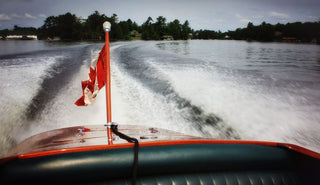Hello there, friends! Are you looking for a fun way to soak up some sunshine and fresh air this time of year? Well, we would like to suggest the tree-mendously fun activity of maple syrup making! It's a long-standing Canadian tradition and an amazing way to appreciate the beauty of Muskoka while making some sweet, yummy maple syrup.
First things first, let's talk about how to identify maple trees in the winter and early spring. In summer this is a no brainer, but with no leaves on branches just yet, it can be a bit tricky to tell maples apart from other species this time of year. There are a few things to look for to help you identify maples during this season: bark, branch formation and buds.
 The bark of a mature maple tree is gray-brown in colour and has deep furrows and ridges running vertically along the trunk. Sometimes older trees have bark that peels off in chunky strips. Some people have a knack for identifying maple trees by their bark, but we find that oaks and maples look too similar to tell them apart by bark alone. Certainly bark helps us distinguish maples from trees like birch or beech or pine, but we need to use other identification keys as well to narrow things down.
The bark of a mature maple tree is gray-brown in colour and has deep furrows and ridges running vertically along the trunk. Sometimes older trees have bark that peels off in chunky strips. Some people have a knack for identifying maple trees by their bark, but we find that oaks and maples look too similar to tell them apart by bark alone. Certainly bark helps us distinguish maples from trees like birch or beech or pine, but we need to use other identification keys as well to narrow things down.

Another thing to watch for is the pattern in which the branches grow. Maple leaves grow opposite to one another on the branch, so when looking at a bare tree at this time of year you will see that the branches are directly opposite of each other, not staggered in an alternating pattern like many other trees. This is a characteristic of maple trees that sets them apart from oaks, and many other species. If you are lucky, you may even see a few of last years leaves stubbornly hanging on, and if so, this makes identification even easier still!
Check out this video from a few years back where we spent some fun with friends at their Sugar Shack.
Lastly, in spring as the maple trees begin to awaken, their first buds are actually flowers, not leaves! Sugar maples have flowers with yellow petals, whereas red and silver maples have red flowers. You won't be seeing the flowers this early in the year, but you may see buds. Right now our red maples, in particular, have small but noticeable red buds. You may want to pay close attention to the colour of the flowers on your maples later this spring to distinguish between species...Even if only for next years sap collection!
This brings us to the fact that not all maple trees are created equal when it comes to tapping for syrup. Sugar maple trees are the most commonly used for syrup making, but red and silver maples can also be tapped. Sugar maples have the highest sugar content in their sap, though, which means they produce the most syrup per tap. So look for those sugars!
The ideal timing for sap to run is when we experience freezing temperatures at night, and daytime temperatures are above 2 degrees celsius. Tapping the tree too early in the season can lead to the taphole drying out and lower sap yields. Conversely, tapping the tree too late in the season may cause sap runs to be missed. There is a risk of harming the tree by splitting its inner bark when tapping deeply into frozen wood, so please be patient and watch the weather carefully!
So, what equipment do you need to get started with maple syrup making? As a beginner, you'll need a few basic things. First, you'll need a drill, some small spiles to tap into the tree as well as some buckets to collect the sap. Lastly, you'll need a large pot (and a good fire pit and lots of wood) or an evaporator to boil the sap down into syrup.
Use a sharp, clean drill to drill a hole that's 2" - 2.5" deep. Gently tap the spile into your chosen maples trees with a hammer (do not pound the spile into the tree, as this may cause the wood to split). If the sap is flowing, you should immediately see it dripping from the spile. The taphole should have a slight downward slope; position considers ease of placing the sap bucket underneath. Taps should be removed promptly at the end of the sap season and left un-plugged to permit proper healing
It's important to properly care for our trees so please use a measuring tape to measure the circumference, 4' from the base, and use the following guidelines before tapping:
- If your trunk is under 31" don't tap it.
- If your trunk is over 31' but under 44", only drill one hole.
- If your trunk is over 44" but under 60", you can drill two holes.
- If your trunk measures more than 61", you can drill 3 holes.
Now, onto the fun part: collecting and boiling the sap! This process can take some time, but it's a great excuse to get outside and enjoy the beautiful spring weather in Muskoka. You'll want to collect the sap daily, or every other day, depending on how much sap your tree is producing. Once you have a good amount, you'll start boiling it down until it reaches the right consistency for syrup.
This process can take anywhere from a few hours to a full day or more, depending on how much sap you have and how fast your sap is evaporating. But don't worry, the end result is well worth the time and effort. There's nothing quite like enjoying a stack of pancakes with fresh, homemade maple syrup
Not only is tapping maple trees a fun and delicious activity, it's also a great way to get outside and enjoy the beauty of Muskoka in the spring. Whether you're going out with family or friends, or just enjoying some time in nature by yourself, there's nothing quite like the feeling of accomplishment that comes with making your own syrup from scratch.
So what are you waiting for? Head out to the woods, and get tapping!












Gary Ewart
What’s the chance of coming out with T-shirts with the image of the ad of the article.
Marg Stewart
Oh my !
What a yrip down Memory Lane – My dad taught me how to do this when I was a kid over 60 years ago in the Laurentians